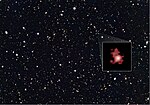astro.wikisort.org - Asteroid
1994 WR12 is an asteroid and near-Earth object approximately 130 meters (430 feet) in diameter.[3][4] As a member of the Aten group almost all of its orbit is closer to the Sun than Earth is. First imaged at Kitami Observatory on 26 November 1994,[1] it was discovered two nights later by American astronomer Carolyn S. Shoemaker at Palomar Observatory on 28 November 1994.[2] The asteroid then went unobserved from 1994 until it was recovered by Mauna Kea in March 2016.[1] It was removed from the Sentry Risk Table on 2 April 2016.[5]
| Date | JPL SBDB nominal geocentric distance |
uncertainty region (3-sigma) |
|---|---|---|
| 2021-11-29 | 6152017 km | ± 74 km[6] |
| 2046-11-25 | 1623763 km | ± 42 km |
| 2190-11-23 | 6450000 km | ± 219 thousand km[7] |
| Discovery[1][2] | |
|---|---|
| Discovered by | C. S. Shoemaker |
| Discovery site | Palomar Obs. |
| Discovery date | 28 November 1994 |
| Designations | |
MPC designation | 1994 WR12 |
Minor planet category | NEO · Aten[1][3] |
| Orbital characteristics[3] | |
| Epoch 2022-Jan-21 (JD 2459600.5) | |
| Uncertainty parameter 0 | |
| Observation arc | 27.01 yr (9,864 d) |
| Aphelion | 1.0577 AU (158.23 million km) |
| Perihelion | 0.4562 AU (68.25 million km) |
Semi-major axis | 0.7570 AU (113.25 million km) |
| Eccentricity | 0.39735 |
Orbital period (sidereal) | 240.6 days (0.659 yr) |
Mean anomaly | 217.06° |
Mean motion | 1° 29m 45.96s / day |
| Inclination | 6.8515° |
Longitude of ascending node | 62.608° |
Argument of perihelion | 206.03° |
| Earth MOID | 0.0018 AU (0.70 LD) |
| Physical characteristics | |
Mean diameter | 130 m (est.)[4] 92 – 210 m (CNEOS) |
| Mass | 2.9×109 kg (est.)[4] |
Absolute magnitude (H) | 22.3[3] |
Description
1994 WR12 orbits the Sun at a distance of 0.5–1.1 AU once every 8 months (240 days). Its orbit has an eccentricity of 0.40 and an inclination of 7° with respect to the ecliptic.[3]
It has an Earth minimum orbital intersection distance of 0.0018 AU (269,000 km), which translates into 0.7 lunar distances.[3] On 25 November 2046, it will pass 1623763 km from Earth with an uncertainty of ±42 km.[3] While listed on the Sentry Risk Table the range for the 2046 close approach distance varied from 0.001 AU (150,000 km) to 0.039 AU (5,800,000 km) from Earth.[8]
While listed on the Sentry Risk Table,[9] virtual clones of the asteroid that fit the uncertainty in the known trajectory showed 116 potential impacts between 2054 and 2109.[4] It had about a cumulative 1 in 9090 chance of impacting the Earth.[4] The formerly poorly known trajectory of this asteroid was further complicated by close approaches to Venus and Mercury.[3] It was recovered by Mauna Kea in March 2016,[1] which extended the observation arc from 34 days to 21 years.
It is estimated that an impact would produce the equivalent of 77 megatons of TNT,[4] roughly 1.5 times that of most powerful nuclear weapon ever detonated (Tsar Bomba).
See also
- Lost asteroids
References
- "1994 WR12". Minor Planet Center. Retrieved 30 June 2020.
- "MPEC 1994-Y05 : 1994 WR12". IAU Minor Planet Center. 21 December 1994. Retrieved 17 October 2011. (J94W12R)
- "JPL Small-Body Database Browser: (1994 WR12)" (2021-11-28 last obs.). Jet Propulsion Laboratory. Archived from the original on 12 April 2017. Retrieved 29 November 2021.
- "Archive: Earth Impact Risk Summary: 1994 WR12". NASA/JPL Near-Earth Object Program Office. 26 March 2016. Archived from the original on 26 March 2016.
- "Removed Objects". NASA/JPL Near-Earth Object Program Office.
- "Horizons Batch for 2021-Nov-29 06:04 UT". JPL Horizons. Archived from the original on 19 November 2021. Retrieved 28 November 2021.
- "Horizons Batch for 2190-Nov-23 22:27 UT". JPL Horizons. Archived from the original on 20 November 2021. Retrieved 29 November 2021.
- "JPL Close-Approach Data: (1994 WR12)". Retrieved 29 November 2021.
"(1994 WR12)". Archived from the original on 13 December 2012. Retrieved 29 January 2018. (last observation: 1994-12-31; arc: 35 days; Uncertainty: 8) - "Archive: Sentry Risk Table". NASA/JPL Near-Earth Object Program Office. 29 May 2013. Archived from the original on 29 May 2013.
External links
- List Of Aten Minor Planets (by designation), Minor Planet Center
- 1994 WR12 at NeoDyS-2, Near Earth Objects—Dynamic Site
- Ephemeris · Obs prediction · Orbital info · MOID · Proper elements · Obs info · Close · Physical info · NEOCC
- 1994 WR12 at ESA–space situational awareness
- 1994 WR12 at the JPL Small-Body Database
Другой контент может иметь иную лицензию. Перед использованием материалов сайта WikiSort.org внимательно изучите правила лицензирования конкретных элементов наполнения сайта.
WikiSort.org - проект по пересортировке и дополнению контента Википедии


